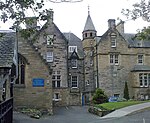The West End of New Town - also known as Edinburgh's West End or West End Village - is an affluent district of Edinburgh, Scotland, which along with the rest of New Town, and also the Old Town forms central Edinburgh, and Edinburgh's UNESCO World Heritage Site. The area boasts several of the city's hotels, restaurants, independent shops, offices and arts venues, including the Edinburgh Filmhouse, Edinburgh International Conference Centre and the Caledonian Hotel. The area also hosts art festivals and crafts fairs.The northern part of the West End of New Town sits on the Water of Leith river and forms part of Edinburgh's UNESCO World Heritage Site. The West End of New Town is contiguous with the rest of New Town and is accordingly included in the New Town Conservation Area. As can be inferred therefore, this area of the city contains many buildings of great architectural beauty, primarily long rows and crescents of Georgian terraced houses. The West End of New Town also incorporates many of the New Town Gardens, a heritage designation since 2001.The district is one of Edinburgh's most affluent areas, and includes many of the most expensive streets in Scotland's capital. Many nations have their consulates in the West End. The Scottish Episcopal Church has its headquarters, Forbes House, in the district and the official residence of the Moderator of the General Assembly of the Church of Scotland is also located here.The West End district is immediately west of the rest of the New Town, and also the Old Town. It is bordered to the north by the Stockbridge and Ravelston districts, Tollcross and Fountainbridge districts to the south, and West Coates, Haymarket and Murrayfield to the West.










